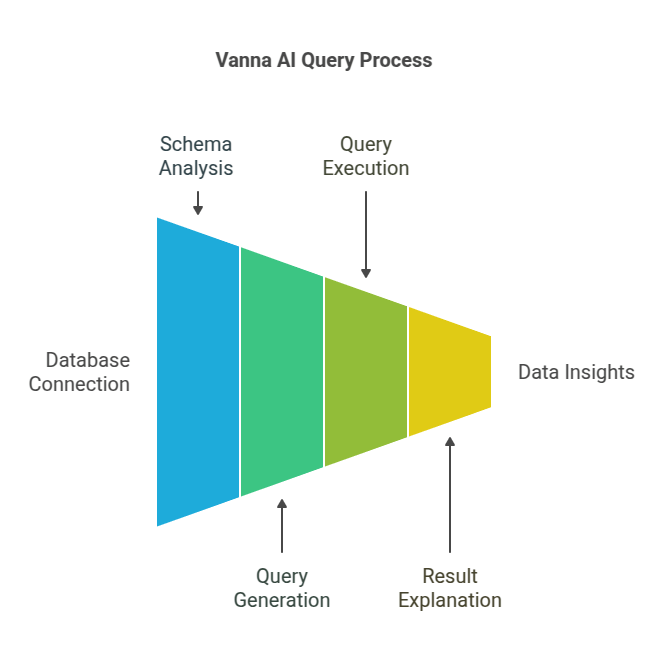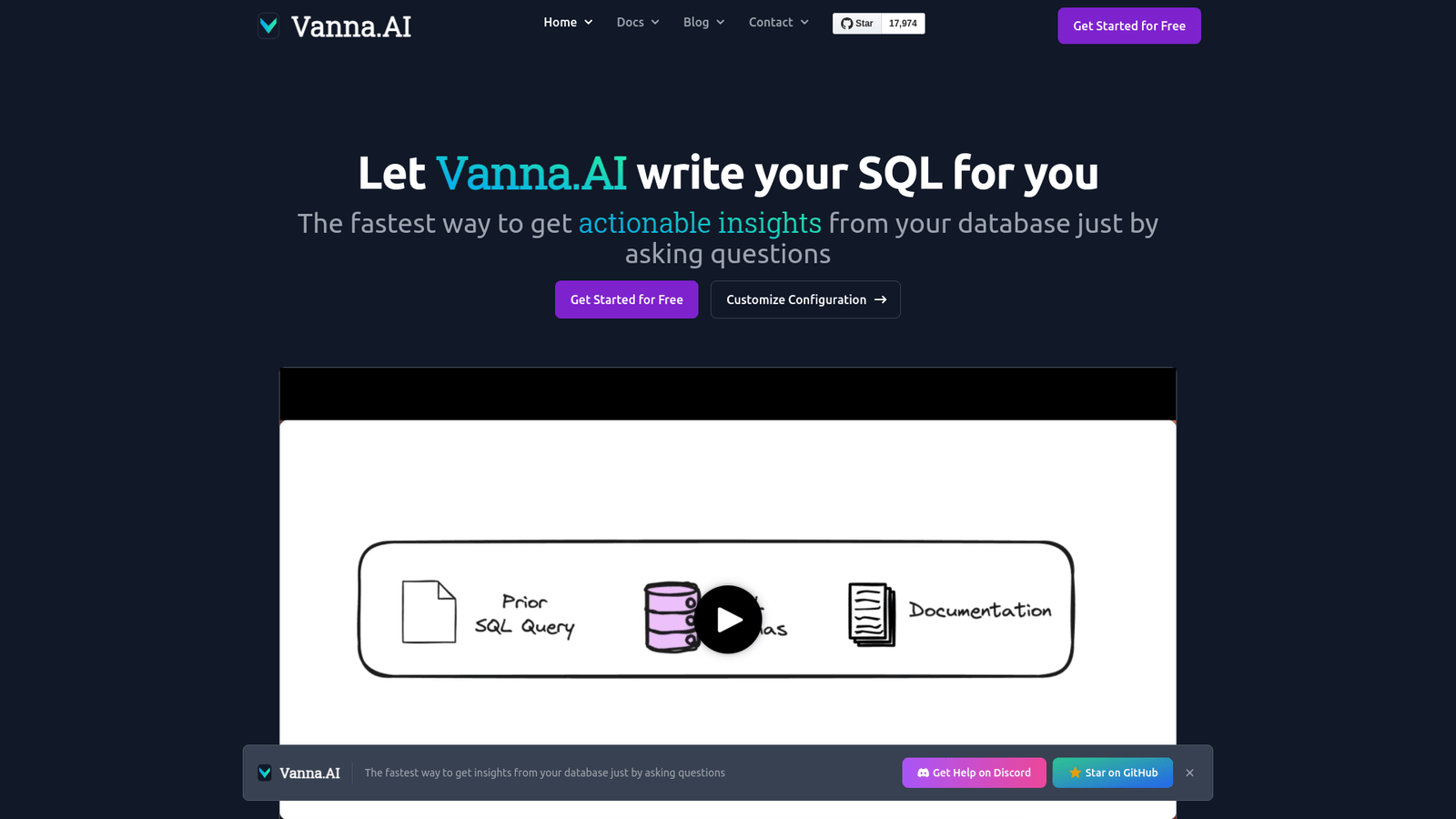Vanna AI simplifies Natural Language Data Querying for Data Analysis & Business Intelligence pros. Get insights fast without complex code. Try Vanna AI today!
Here’s What Happened When I Tried Vanna AI for Natural Language Data Querying
Okay, look.
Everyone’s talking about AI.
Seems like every tool under the sun is slapping “AI” on it.
Especially in the world of Data Analysis and Business Intelligence.
It’s getting crowded.
Most of it? Fluff.
But then I stumbled across Vanna AI.
Specifically, how it handles something critical: Natural Language Data Querying.
Or NLDQ, as I started calling it.
Asking your data questions using plain English.
Like you’re talking to a person.
Sounded like hype.
I was skeptical.
Very skeptical.
Most tools promise the moon and deliver a rock.
But I decided to give it a shot.
Why?
Because manual NLDQ is a pain.
Translating business questions into SQL? Tedious. Error-prone. Slow.
Especially when you need insights fast.
So, I committed.
I spent some time with Vanna AI.
Put it through its paces.
Here’s what went down.
Here’s the real story.
Table of Contents
- What is Vanna AI?
- Key Features of Vanna AI for Natural Language Data Querying
- Benefits of Using Vanna AI for Data Analysis and Business Intelligence
- Pricing & Plans
- Hands-On Experience / Use Cases
- Who Should Use Vanna AI?
- How to Make Money Using Vanna AI
- Limitations and Considerations
- Final Thoughts
- Frequently Asked Questions
What is Vanna AI?
Alright, let’s cut to the chase.
What exactly is Vanna AI?
At its core, Vanna AI is an AI assistant built for your database.
Think of it as a translator.
It takes your everyday language – your questions, your requests – and turns them into database queries.
Specifically, SQL queries.
The technical language databases understand.
So, instead of writing “SELECT * FROM sales WHERE region = ‘East’ AND revenue > 100000”, you might type something like “Show me sales data for the East region where revenue was over 100k”.
Vanna AI does the translation.
The heavy lifting.
It’s designed for anyone who needs to get answers from their data but doesn’t want to wrestle with SQL syntax.
This means data analysts, business intelligence professionals, marketers, product managers, executives.
Basically, anyone who uses data to make decisions.
It connects directly to your database.
It learns your database schema.
It understands the structure.
This isn’t just some generic language model trying to guess.
It’s trained on your specific data setup.
That’s a key difference.
It aims to provide accurate, executable SQL.
Not just suggestions.
It’s all about making data accessible.
Putting the power of querying into the hands of people who aren’t necessarily SQL wizards.
In short, it simplifies data access.
It speeds things up.
It bridges the gap between business questions and technical data retrieval.
That’s the promise.
Key Features of Vanna AI for Natural Language Data Querying
Okay, so what does this thing actually *do*?
How does it work its magic with Natural Language Data Querying?
Here are the features that stand out.
- Feature 1: Database Schema Understanding
This is foundational.
Vanna AI doesn’t just guess.
It connects to your database.
It ingests your schema.
It learns your table names, column names, data types, and relationships.
It understands how your data is structured.
Why does this matter?
Because it can generate queries that are actually valid for *your* database.
It’s not trying to write SQL for a generic database structure.
It knows you have a table called ‘customers’ and it has columns like ‘customer_id’, ‘name’, and ‘signup_date’.
This drastically improves the accuracy and relevance of the generated SQL.
Less guesswork, more precision.
- Feature 2: Natural Language to SQL Translation
This is the core functionality.
You type in a question in plain English.
Something like, “What is the total revenue from sales in the last quarter?”
Vanna AI processes that natural language input.
It uses its understanding of your schema and AI models to translate that into a valid SQL query.
It figures out which tables to join, which columns to select, what filters to apply, and how to aggregate the data (like summing revenue).
The output isn’t just the SQL query itself.
It often provides an explanation of the query.
Why it chose certain tables or conditions.
This is huge for learning.
It’s not just a black box; it’s a teaching tool.
You see the SQL, understand the logic, and can even tweak it if needed.
- Feature 3: Contextual Understanding and Refinement
Querying data often isn’t a one-shot deal.
You ask a question, get a result, then ask a follow-up.
“Okay, now show me that broken down by product category.”
Or, “What about the quarter before that?”
Vanna AI is designed to maintain context.
It remembers previous questions and answers in a session.
This means you can ask follow-up questions without repeating all the initial conditions.
It understands that “that” refers to the previous query’s context.
This makes the conversation with your data feel more natural.
It speeds up iterative analysis.
Instead of starting from scratch with each new question, you build upon the last one.
It’s like having a data analyst who actually remembers what you just talked about.
These features combine to make NLDQ not just possible, but genuinely practical for daily data work.
Benefits of Using Vanna AI for Data Analysis and Business Intelligence

Alright, why should you care about Vanna AI if you’re in Data Analysis and Business Intelligence?
What’s the actual payoff?
Let’s talk benefits.
Time Savings: This is the big one.
Writing SQL takes time.
Understanding complex schemas takes time.
Debugging queries when you get syntax wrong takes time.
Vanna AI cuts through that.
You type your question in seconds.
It generates the query typically in seconds.
You get the answer much, much faster.
Imagine the hours saved over a week.
Over a month.
That time can be spent on actual analysis.
Interpreting results.
Making decisions.
Not wrestling with commas and joins.
Increased Accessibility: Not everyone on a team is a SQL expert.
Product managers, marketers, sales reps – they all need data.
Often, they have to go through a data team to get it.
This creates bottlenecks.
Vanna AI lets these non-technical users query data themselves.
Using language they’re comfortable with.
It democratizes data access.
Empowers more people to get the information they need when they need it.
Reduces the load on the data team for routine requests.
Improved Query Quality: Okay, AI isn’t perfect.
But Vanna AI, specifically trained on your schema, is pretty good at generating correct SQL.
It can handle complex joins and aggregations that might trip up someone less experienced.
Or even lead to errors for someone experienced working under pressure.
It provides a starting point that is often correct.
You can review the generated SQL.
Learn from it.
Tweak it if necessary.
But you’re starting from a high-quality baseline, not a blank page.
Faster Iteration: Data analysis is iterative.
You ask a question, look at the answer, ask a slightly different question.
Vanna AI’s contextual understanding means you can chain queries together quickly.
Explore different angles of the data without writing full SQL queries each time.
This accelerates the entire analysis process.
Leads to faster insights.
Quicker decision-making.
That’s the point of data, right?
Not just having it, but using it effectively.
Vanna AI helps you do that.
Pricing & Plans
Alright, show me the money.
What does this cost?
Like most tools worth their salt, Vanna AI isn’t free forever.
But they usually have options.
They offer a free tier.
This is key.
You can try it out.
Connect it to your database.
Kick the tires.
See if it actually understands your schema and generates useful queries.
The free plan is typically limited in usage.
Maybe a certain number of queries per month.
Or limitations on the size/complexity of the database it can handle.
But it’s enough to prove the concept.
To see if it fits your workflow.
If you like it – if you see the value – they have paid plans.
These plans scale up.
More queries.
Support for larger or more complex databases.
Team features.
Enhanced security or deployment options (like self-hosting).
They position themselves as a tool for businesses.
So, pricing reflects that value proposition.
Compared to alternatives?
“Alternatives” in this space are often:
1. More expensive, enterprise-level BI platforms with NLDQ features.
2. Generic AI models that *can* write SQL, but require you to paste schema information and lack direct database integration and context.
3. Hiring more data analysts (which is expensive and slower for ad-hoc requests).
Vanna AI aims to be more affordable than enterprise BI suites and far more practical/accurate than using general-purpose AI for this task.
The cost needs to be weighed against the time saved and the increased data access.
For many teams, the ROI on even a paid plan could be significant just in terms of analyst time freed up.
Check their official site for the most up-to-date pricing structure.
Plans change.
But start with the free tier.
See if it works for you before you commit.
Hands-On Experience / Use Cases

Enough theory.
What’s it actually like to *use* Vanna AI?
I hooked it up to a sample database.
Nothing massive, but representative of a small e-commerce store.
Tables like `orders`, `customers`, `products`, `order_items`.
First step: connecting.
Pretty straightforward.
You provide your database credentials.
It connects.
Then, it analyses the schema.
This takes a few minutes depending on size.
It builds an internal representation.
Learns the lay of the land.
Then, the querying begins.
I started simple.
“Show me the total number of orders.”
It generated `SELECT COUNT(*) FROM orders;`.
Ran it.
Got the number.
Spot on.
Okay, ramp it up.
“What’s the average order value?”
It figured out I needed to sum the `total_amount` from `orders` and divide by the count.
Generated the correct query.
Next, something trickier.
“List the names of customers who have placed more than 5 orders.”
This requires a join between `customers` and `orders`.
A GROUP BY on customer name.
And a HAVING clause to filter for counts > 5.
Vanna AI nailed it.
Generated the complex query correctly.
The explanations it provides for *why* it generated a specific query were super helpful.
Especially for complex ones.
You could see the logic.
Understand how it interpreted your request.
Then I tried the contextual stuff.
“Show me the total revenue by month for last year.”
Got the result.
Then I just typed: “Now break that down by product category.”
It didn’t forget the “last year” part.
It added the necessary joins to the `products` table and the GROUP BY on `category`.
That felt powerful.
Like a real conversation with the data.
Use Cases I saw immediately:
Marketing Attribution: “Show me sales generated from the ‘Spring_Campaign_2023’ campaign tag.”
Product Performance: “Which product categories had the highest sales volume last quarter?”
Customer Segmentation: “List customers in London who haven’t ordered in 6 months.”
Operational Reporting: “How many pending orders are there?”
The usability was smooth.
The interface is clean.
The speed was impressive.
It actually delivers on the promise of Natural Language Data Querying.
It’s not just a gimmick.
Who Should Use Vanna AI?
Okay, so who is this tool for?
Who gets the most bang for their buck with Vanna AI?
It’s not *just* for data scientists.
In fact, data scientists might use it differently.
Here’s the breakdown:
Data Analysts: This is an obvious one.
Analysts spend huge amounts of time writing and debugging SQL.
Vanna AI can significantly speed up the initial query generation.
It’s a powerful assistant.
They can verify the SQL, learn from it, and focus on the deeper analysis.
It reduces the tedious part of their job.
Business Intelligence Professionals: BI folks are all about getting data to stakeholders.
Creating dashboards, generating reports.
Vanna AI makes it easier to explore the data underlying these reports.
To answer ad-hoc questions that weren’t planned for in the dashboards.
Quickly pulling numbers for a meeting.
It improves agility.
Product Managers: Need to know feature usage?
User behaviour?
Impact of a new release?
Product managers often have critical data questions but lack the technical skills to query directly.
Vanna AI empowers them to self-serve.
Get answers without waiting for the data team.
Faster insights mean better product decisions.
Marketers: ROI of campaigns?
Customer segments?
Website traffic sources converted to sales?
Marketers are heavy data consumers.
Vanna AI allows them to directly query customer and campaign data.
Analyze performance without relying on canned reports.
Make data-driven marketing decisions faster.
Executives and Managers: Need a quick stat for a board meeting?
A top-level overview of performance?
Executives rarely have time to learn SQL.
But they have questions.
Vanna AI could allow them (or their assistants) to get those high-level numbers instantly.
Directly from the source.
Small Businesses without Dedicated Data Teams: If you have a database but no SQL expert on staff, Vanna AI is a lifeline.
It unlocks the value of your data.
Lets non-technical founders or employees ask questions and get answers.
Avoids the cost and delay of hiring a data consultant for basic queries.
Anyone who interacts with a database and wishes they could just *ask* it a question. That’s the target audience.
How to Make Money Using Vanna AI

Okay, the juicy part.
Can you actually make money with this tool?
Absolutely.
It’s about leveraging the efficiency and access Vanna AI provides.
Here’s how:
- Service 1: Offer Data Querying as a Service (for non-technical clients)
Many small businesses, non-profits, or individuals have data in databases but zero technical skills to access it.
They rely on clunky interfaces or manual exports.
You can offer a service: “Need answers from your database? Ask me in plain English, I’ll get you the data.”
Use Vanna AI to connect to their database (with their permission, obviously).
You act as the intermediary.
They give you natural language questions (“How many new members joined last month?”, “List all donors who gave over £500 last year?”).
You plug those into Vanna AI.
Get the SQL.
Run it (or provide the SQL for them to run).
Deliver the clean data or a summary.
Charge per query, per hour, or a monthly retainer.
Vanna AI makes *you* incredibly efficient at this.
You don’t need to be a senior DBA.
- Service 2: Speed Up Data Analysis Projects (Freelancers/Agencies)
If you’re a freelance data analyst or run a small agency, time is money.
The faster you deliver, the more projects you can take on.
Use Vanna AI to accelerate the data extraction phase of your projects.
Connecting to a new client’s database? Vanna AI learns the schema fast.
Need to pull a complex dataset for analysis? Type the request in English.
Spend less time writing boilerplate SQL and more time on the valuable part: the analysis, the insights, the visualizations.
This efficiency boost directly translates to increased profitability per project.
You can take on more clients or deliver faster turnarounds, justifying higher rates.
- Service 3: Create and Sell Custom Reports/Dashboards (Powered by Quick Data Access)
Many businesses need specific reports but don’t have the tools or skills to build them.
You can specialize in creating custom reports or simple dashboards.
Vanna AI helps you quickly pull the *exact* data needed for these reports.
No more back-and-forth trying to explain data requirements or waiting for manual data pulls.
You understand their business need (“Show me sales trends for our top 10 products over the last quarter”), plug the natural language query into Vanna AI, get the data, and build the report.
Offer this as a premium service.
The speed Vanna AI gives you means you can build more reports or offer them at a competitive price while maintaining margin.
Imagine a scenario: A small marketing agency needs to frequently pull specific lead generation metrics from their CRM database for different clients. Manually writing SQL for each client’s slightly different setup is slow. Using Vanna AI, they connect to each client’s database once, and then their non-technical client managers can pull reports just by asking questions in English. They save hours per week, allowing them to serve more clients without hiring more data staff. That’s a direct impact on profit.
Limitations and Considerations
Okay, let’s keep it real.
No tool is a magic bullet.
Vanna AI is powerful, but it has limits.
And things you need to consider.
Accuracy Isn’t 100%: While Vanna AI is good, especially with its schema understanding, it won’t always generate the perfect query on the first try.
Natural language is ambiguous.
Databases can be complex.
Sometimes, you might need to rephrase your question.
Or slightly edit the generated SQL.
It’s an assistant, not a replacement for understanding your data or basic SQL concepts.
Requires Database Access: Obvious, but worth stating.
You need to be able to connect Vanna AI to your database.
This might involve coordinating with IT or database administrators.
Security and permissions need to be handled correctly.
You can’t just point it at any random data source if you don’t have the keys.
Schema Complexity: The more complex your database schema, the harder it is for any NLDQ tool.
If you have hundreds of tables with cryptic names and no clear relationships defined, Vanna AI (or a human) will struggle.
Well-structured databases yield better results.
Adding descriptions or comments to your schema can help Vanna AI understand context.
Data Security and Privacy: You are connecting an AI tool to your potentially sensitive data.
Understanding how Vanna AI handles data is crucial.
Does the data leave your environment?
Is it stored?
What are their security protocols?
For highly sensitive data, internal deployment options (if available) or careful security reviews are necessary.
Learning Curve (for some): While designed for ease of use, getting the *best* results still requires learning how to phrase questions effectively for an AI.
Understanding its capabilities.
And being able to at least *read* the generated SQL is beneficial for verification.
It’s less of a curve than learning SQL from scratch, but it’s not zero.
It’s a tool.
Like any tool, you need to understand how to use it correctly to get the most out of it.
Manage expectations.
It won’t solve all your data problems instantly.
But it solves a big one – the NLDQ challenge – really well.
Final Thoughts
So, after putting Vanna AI through its paces.
What’s the verdict?
If you work with data.
If you or your team spend valuable time translating business questions into SQL.
If you have non-technical people who need data access but are blocked by technology.
Vanna AI is absolutely worth looking at.
It’s not just another AI gimmick.
It solves a real problem in the Data Analysis and Business Intelligence space.
The promise of Natural Language Data Querying has been around for a while.
Vanna AI is one of the most practical and effective implementations I’ve seen.
Its ability to connect directly to your schema and learn your specific data structure is the key differentiator.
It moves NLDQ from a theoretical concept to a daily usable tool.
It frees up skilled analysts for higher-value work.
It empowers more people across the business to get the insights they need.
It accelerates the pace of decision-making.
Yes, there are considerations – pricing, database access, needing to verify queries.
But the benefits for teams struggling with data bottlenecks and SQL dependency are huge.
My recommendation?
Start with their free tier.
Connect it to a non-production database or a subset of your data.
See how it performs with *your* schema and *your* typical questions.
Test its accuracy.
See how much time it saves you or your team.
I think you’ll be impressed.
This isn’t hype.
It’s a tool that genuinely changes how you interact with data.
For the better.
Visit the official Vanna AI website
Frequently Asked Questions
1. What is Vanna AI used for?
Vanna AI is primarily used for generating SQL queries from natural language questions. It connects to your database, learns your schema, and allows users to ask questions in plain English to retrieve data without needing to write code. It’s used in Data Analysis and Business Intelligence to make data more accessible.
2. Is Vanna AI free?
Vanna AI typically offers a free tier with limited usage. They also have paid plans that provide more queries, support for larger databases, and team features for users needing more extensive capabilities. Check their official website for specific plan details.
3. How does Vanna AI compare to other AI tools?
Compared to generic large language models, Vanna AI specializes specifically in Natural Language Data Querying. Its key advantage is direct integration with your database schema, which allows it to generate more accurate and relevant SQL queries tailored to your specific data structure, unlike general AI that lacks this context.
4. Can beginners use Vanna AI?
Yes, Vanna AI is designed to lower the barrier to entry for data querying. Beginners who don’t know SQL can use it to ask questions in natural language. While some basic understanding of data concepts helps, the tool aims to empower non-technical users to access data.
5. Does the content created by Vanna AI meet quality and optimization standards?
Vanna AI generates SQL queries, not content like articles or marketing copy. The quality of the *queries* generated is generally high due to its schema understanding, but it’s always recommended to review the generated SQL before executing it, especially for critical operations.
6. Can I make money with Vanna AI?
Yes, you can make money by leveraging Vanna AI’s efficiency. You can offer data querying services to non-technical clients, use it to speed up your own freelance data analysis or BI projects, or create and sell custom reports powered by quick data extraction via the tool.






